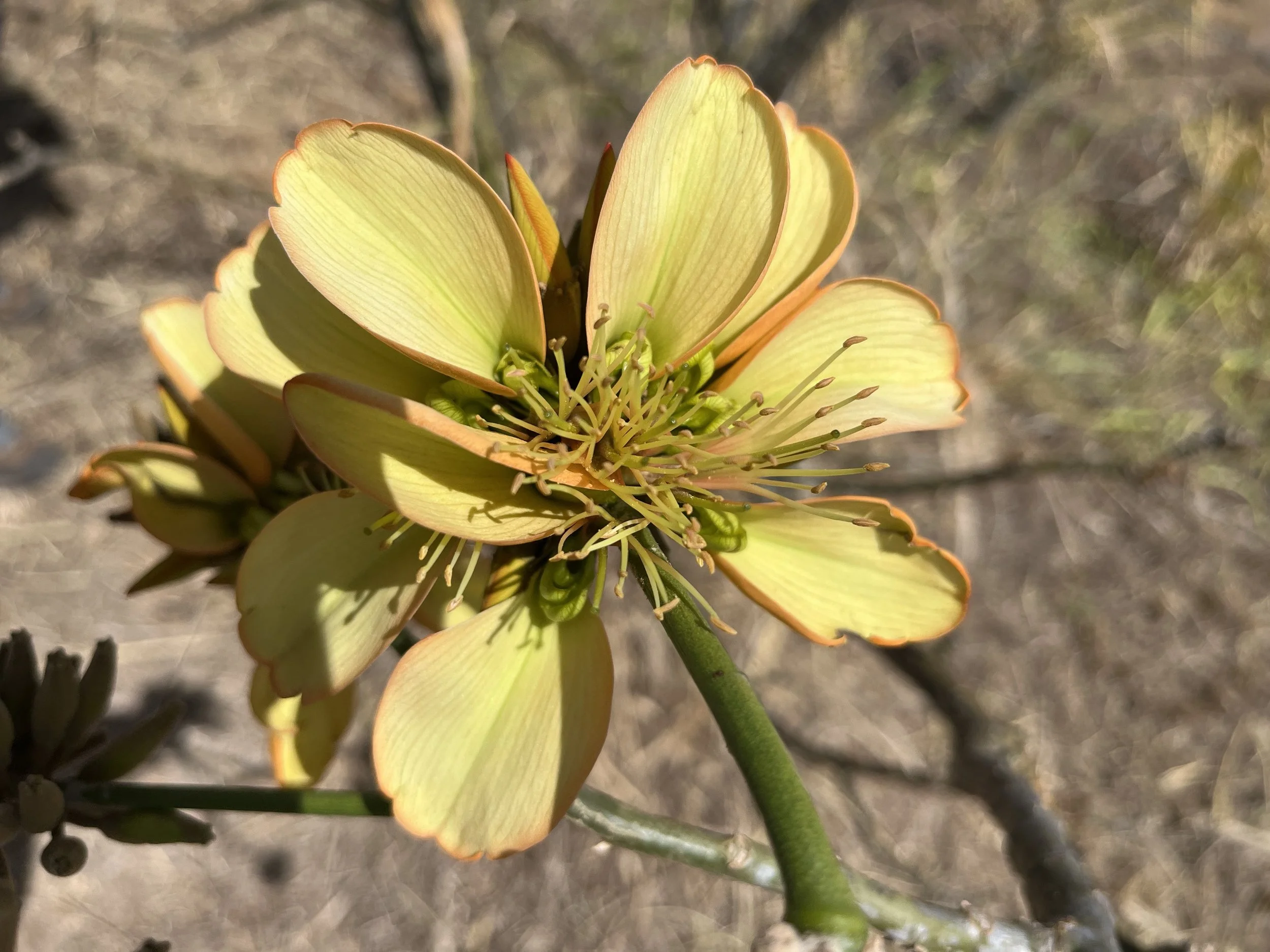Why Pālehua Is Important for Native Ecosystem Restoration
Wiliwili flowering at Pālehua, picture taken by ʻāina programs manager Aliah Irvine
In 2025, Pālehua Conservation Initiative officially started a new program rooted in a timeless tradition – the collection, storing, and propagation of seeds. In collaboration with Protect and Preserve Hawaii, Bishop Museum, and Gill ʻEwa Lands, we have begun contributing to a 3-year seed banking program to conserve native species through seed collection and native plant orchards. By the end of the project, the goal is to support the commercial production needs of partners with seed processing and storage.
Why is this important? Between the degradation of Hawaiʻi’s ecosystems, loss of native forests, and other risk factors including climate change, the islands are experiencing a very high rate of extinction of plant and animal species. Of the 1,375 vascular plant taxa in Hawaiʻi, 634 are listed as Vulnerable or at a higher extinction risk category, 447 are federally listed as Threatened or Endangered, 27 are extinct in the wild, and 108 are extinct. This threat to native plants isn’t a theoretical problem – the lack of native plants growing in the wild combined with the ubiquity of invasive species and changing climate are increasing the risk of wildfires and reducing the water-carrying capacity of our aquifers.
Thankfully, there is an amazing array of community-led conservation organizations in Hawaiʻi working to restore native ecosystems–at least 35 organizations on Oʻahu alone. However, only a few species of native plants are regularly available in significant quantities for restoration work. This is because natural populations of plants are highly fragmented and often only found in remote areas. Many of the remaining populations consist of just a few individuals.
Reproduction in the wild is also difficult for native taxa for a number of reasons ranging from lack of pollinators to out-competition by non-native species. Despite the difficulty plants face in the wild, Pālehua is fortunate to have an abundant seed bank. With many helping hands from volunteers and staff, Pālehua is able to work in clearing out various remote areas in the mauna where we can see success. For instance, in a couple of our kīpuka, koa seedlings along with many other native babies are sprouting in abundance. Although Pālehua has a long way to go, we are hopeful that one day our kūpuna laʻau will be able to produce an array of seeds to regenerate the next generation of laʻau as well as meet the long term goal to help overcome the acute native seed shortage.
Pālehua is a special place with an array of native species. As part of the program, our conservation team has been heading out into the forest and looking for seeds. After they are gathered and processed, the seeds are either stored until ready for planting; given to Bishop museum to be processed, saved, and grown; or shared with other partners including Mālama Learning Center to grow in its nursery in preparation for outplanting. PCI’s team has also recently started a nursery for propagation.
So far, our conservation team has collected seeds of more than a dozen species: lonomea, aʻaliʻi, ʻilima, Erythrina sandwicensis (wiliwili), ʻukiʻuki, ʻaweoweo, Nestegis sandwicensis (ʻolopua), Bidens torta (koʻokoʻolau), Gahnia beechey (ʻuki), viola chamissoniana (pāmakani), Abutilon incanum (maʻo), ʻīliahi (sandalwood), Pouteria sandwicensis (ʻālaʻa), Santalaum freycinetianum, and Panicum nephilophilum, a native grass.
By supporting conservation organizations across the island through native seed sourcing, processing, storage, and germination services, this seed banking project aims to restore native ecosystems on the island of Oʻahu and inspire similar efforts other islands as well. We also aim to maximize genetic diversity within seed zones and ensure that seeds are planted back into the seed zones from which they originated. The seeds gathered at Pālehua will support diversification of propagules in the area, including the kuahiwi from which the seeds came.
Another long-term goal of the project is an information tool about the occurrences, distribution, and potential distribution due to climate change of native species. The tool will support education and research and be a valuable resource for commercial native seed operations and native ecosystem restoration work throughout Hawaiʻi.
We’re off to a great start! But for the program to have a thriving network, our hui also needs other committed partners passionate about conservation and willing to dedicate their lands, staff, and resources to the effort. We also need partners who manage natural areas and will allow seeds to be collected from those areas. If you know any land managers or conservation groups that may be interested, please have them contact Bishop Museum to become part of the growing network!
This approach represents a paradigm shift for climate resilience, disaster recovery, and native ecosystem restoration in Hawaiʻi. We also hope the network can serve as a model for other islands in the state and other regions across the country. Obviously these are grand aspirations, but it all comes down to one special ingredient – seeds from native species still growing here, in the forests of the Waianaʻe Mountains and around the islands.
Thank you for helping us care for Pālehua!

